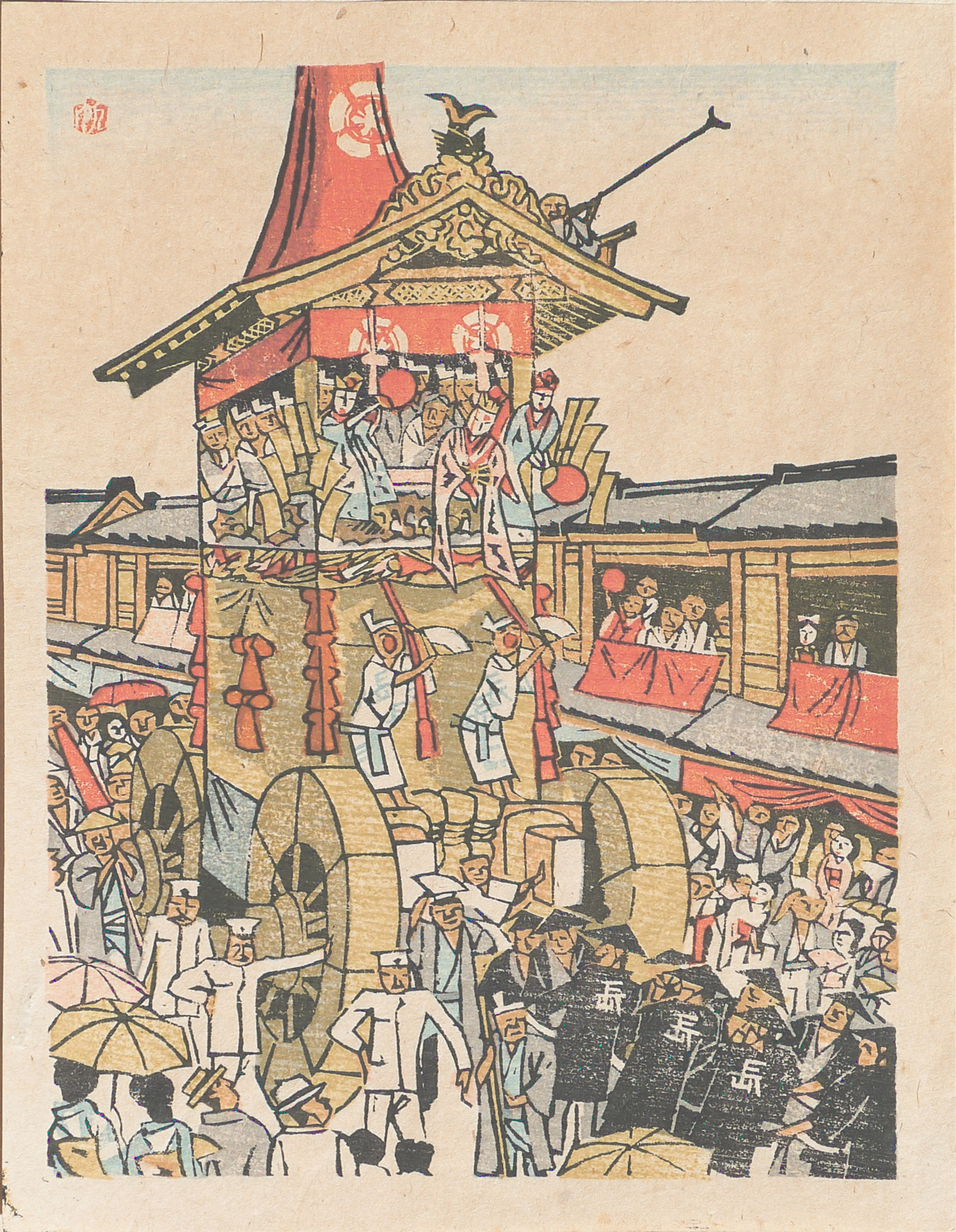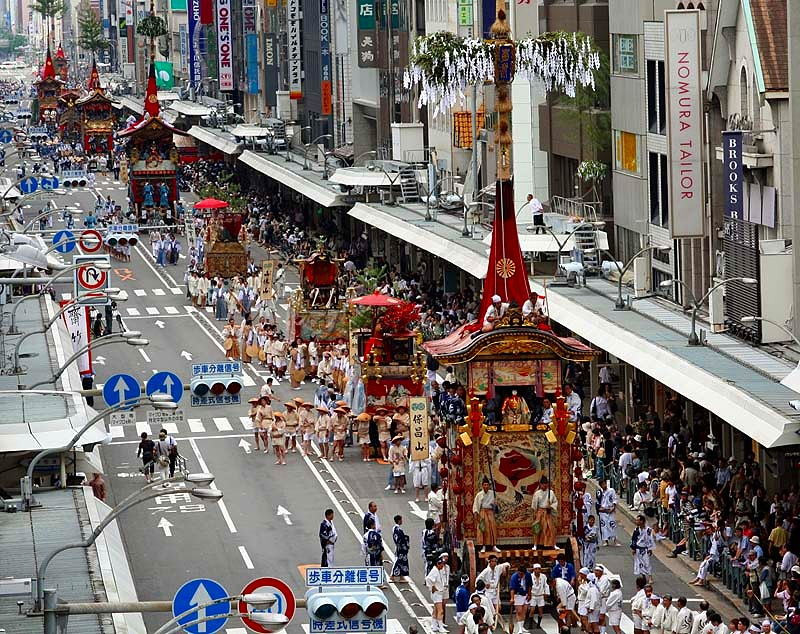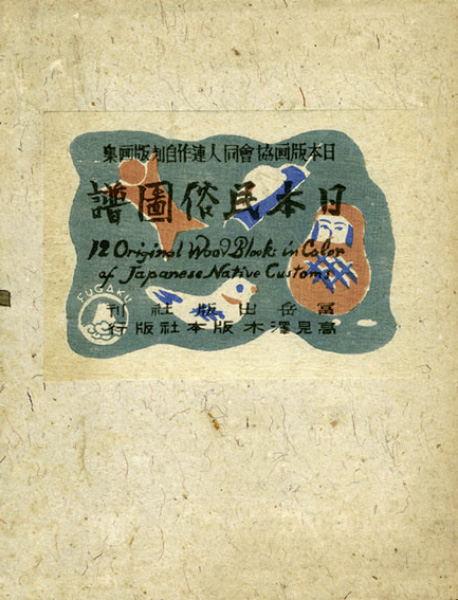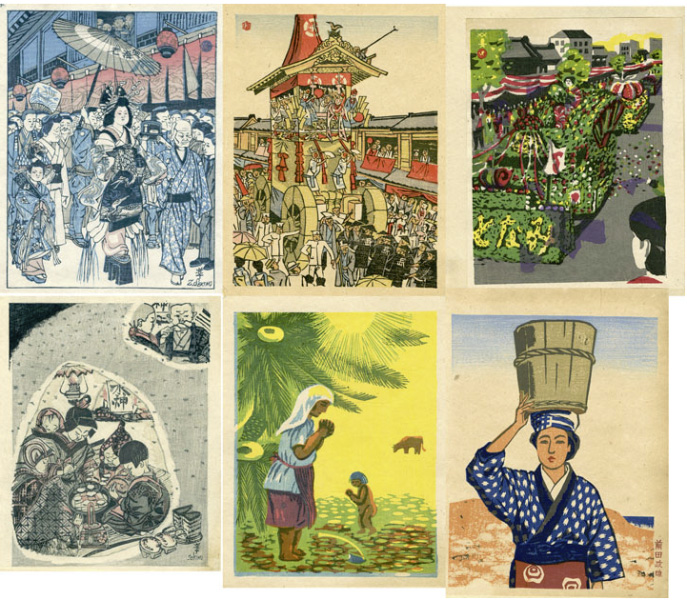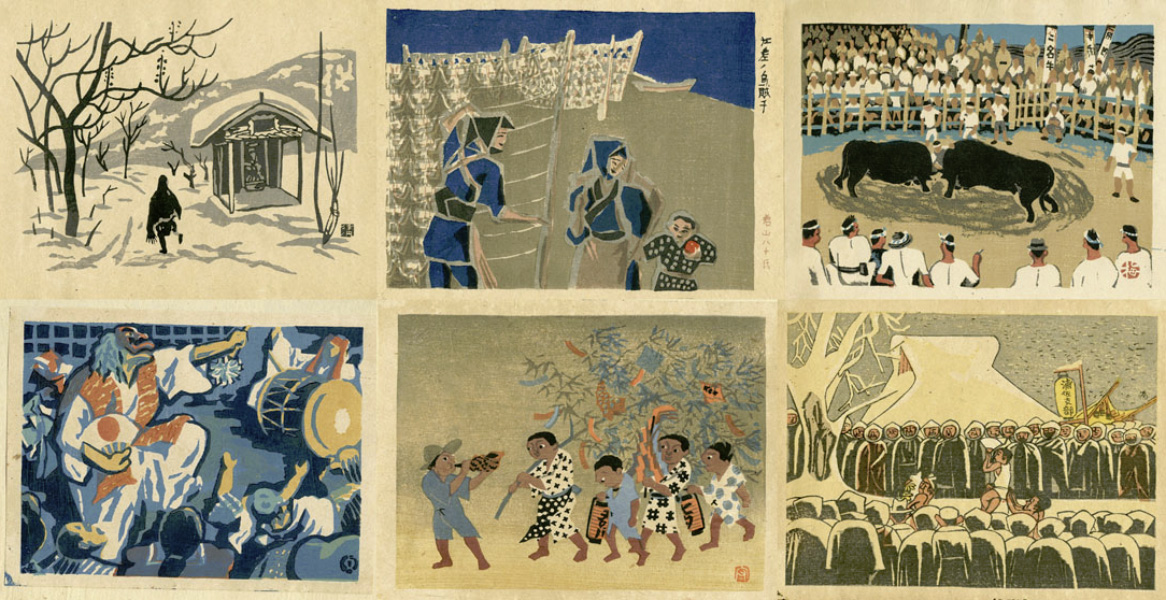About This Print
One of twelve prints from the series Picture Notes on Native Customs of Japan depicting folk rituals from different parts of Japan. It is suggested by Lawrence Smith that the prints paid homage to the Folk Art (mingei) movement that Onchi Kōshirō (1891-1955), who played an unspecified role in issuing this series, was sympathetic to.1In the Artist's Words
| The Gion Festival is held on July 17th and 24th in Kyoto. The musicians on the large float play elegant "Gion-bayashi" tunes during the procession. The festival officials show their precious antiques and pictures to the spectators which is a unique custom of this festival. - Maekawa Senpan |
1 Japanese Prints During the Allied Occupation 1945-1952, Lawrence Smith, British Museum Press, 2003, p. 26.
Gion Festival
Source: Welcome to Kyoto website www.pref.kyoto.jp/visitkyoto/en/info_required/traditional/kyoto_city/02/This festival originated during the outbreak of a pestilence in 869, when the people prayed to the deity of Gion - jinja Shrine, Susano-onomikoto, to rid the land of the pestilence. The festival lasts for about one month. The highlight is the Yamaboko Float Parade on the 17th. Thirty-two of these floats leave Shijo Karasuma at 9:00 in the morning and travel down Shijo-dori to Kawaramachi-dori, then to Oike-dori.
About the Series Picture Notes on Native Customs of Japan
Source: Modern Japanese Woodblock Prints - The Early Years, Helen Merritt, University of Hawaii Press, 1998, p. 284.This series of prints followed on the heals of the series Scenes of Last Tokyo (Tokyo kaiko zue), printed in December 1945 and issued by the same publisher, Uemura Masuo of Fugaku Shuppansha.
"Early in the following year, on 20 March 1946, Uemura Masuo and Fugaku Shuppansha published another set, Nihon minzokuzū-fu (Native Customs in Japan). The editor's statement, which was written in English and accompanied each set, is given here just as it was written to retain its full warmth and flavor:
| Japan is now on the start-line to the new development. Getting free from militarism Japan is expected to be developed to a nation of civilization. At this time of change, it may be interesting to look back [on] the native customs and festivals as to realize the future images of Japan. These humble customs and festivals will also become the mother's milk for Japanese people to bring up the peaceful heart filled with love and piousness. With this purpose the present album has been compiled. The artists are the members of the Japan Artist Engraving Society and are the experts of the Contemporary Original-Engraving in Japan. Japan has been revived to the lovable Japan. We have great pleasure to send you this album at the present delightful time. - Editor |
...All of the artists except Kuroki Sadao had participated in Ichimokukai, and their participation in this set can probably be attributed to Uemura's friendship with Onchi."
Series Print Titles and ArtistsSources: Guide to Modern Japanese Woodblock Prints: 1900-1975, Helen Merritt, University of Hawaii Press, 1992, p. 277 and the website of the National Library of Australia catalogue.nla.gov.au/Record/4653042.
The artists of this set were Azechi Umetarō, Kawanishi Hide, Kuroki Sadao, Maeda Masao, Maekawa Senpan, Mori Dōshun, Saitō Kiyoshi, Sekino Jun'ichirō, Wakayama Yasoji, and Yamaguch Gen. Published by Uemura Masuo of Fugaku Shuppansha, formerly of Takamizawa Mokuhansha. The prints were matted and presented in gray coardboard folders with names of artists and titles translated into English on accompanying sheets.
Gion Festival (Gion matsuri 祇園祭) by Maekawa Senpan (1888-1960)
Festival in Urasa (Urasa no hadaka matsuri 浦佐の裸祭) by Maekawa Senpan (1888-1960)
Tanbata Festival in Hida (Hida no tanabata matsuri 飛騨の七夕祭) by Mori Dōshun (1909-1985)
Winter in Aizu (Aizu no fuyu 会津の冬) by Saitō Kiyoshi (1907-1997)
Snow Room (Yukimuro 雪むろ) by Sekinō Jun’ichiro (1914-1988)
Oiran Parade (Oiran dōchū 花魁道中) by Sekinō Jun’ichiro (1914-1988)
Port Festival (Minato matsuri みなと祭) by Kawanishi Hide (1894-1965)
Fighting Bulls of Iyo (Iyo no tōgyū 伊予の闘牛) by Azechi Umetarō (1902-1999)
Iwatokagura Play (Iwato kagura 岩戸神楽) by Kuroki Sadao (1908-1984)
Maid of Oshima (Ōshima no anko 大島のアンコ) by Maeda Masao (1904-1974)
Drying Cuttlefish in Esashi (Esashi no ikahoshi 江差の烏賊干) by Wakayama Yasouji (1903-1983)
Evening Bell in Amakusa (Amakusa no banshō 天草の晩鐘) by / Yamaguchi Gen
Festival in Urasa (Urasa no hadaka matsuri 浦佐の裸祭) by Maekawa Senpan (1888-1960)
Tanbata Festival in Hida (Hida no tanabata matsuri 飛騨の七夕祭) by Mori Dōshun (1909-1985)
Winter in Aizu (Aizu no fuyu 会津の冬) by Saitō Kiyoshi (1907-1997)
Snow Room (Yukimuro 雪むろ) by Sekinō Jun’ichiro (1914-1988)
Oiran Parade (Oiran dōchū 花魁道中) by Sekinō Jun’ichiro (1914-1988)
Port Festival (Minato matsuri みなと祭) by Kawanishi Hide (1894-1965)
Fighting Bulls of Iyo (Iyo no tōgyū 伊予の闘牛) by Azechi Umetarō (1902-1999)
Iwatokagura Play (Iwato kagura 岩戸神楽) by Kuroki Sadao (1908-1984)
Maid of Oshima (Ōshima no anko 大島のアンコ) by Maeda Masao (1904-1974)
Drying Cuttlefish in Esashi (Esashi no ikahoshi 江差の烏賊干) by Wakayama Yasouji (1903-1983)
Evening Bell in Amakusa (Amakusa no banshō 天草の晩鐘) by / Yamaguchi Gen
Print Details
| IHL Catalog | #1016 |
| Title/Description | Gion Matsuri 祇園祭 (Gion Festival) |
| Series | Picture Notes on Native Customs of Japan 日本民俗図譜 Nihon Minzoku Zufu |
| Artist | Maekawa Senpan (1888-1960) |
| Signature | |
| Seal |  |
| Publication Date | 1946 |
| Publisher | Fugaku Shuppan-sha 富岳出版社 |
| Printing | Takamizawa mokuhan honsha 高見澤木版本社版 |
| Impression | excellent |
| Colors | excellent |
| Condition | excellent - in original folder with slight toning from folder acidity |
| Miscellaneous |  Label attached to verso Label attached to verso |
| Genre | sosaku hanga (creative prints) |
| Format | |
| H x W Paper | 10 1/2 x 8 in. (26.7 x 20.3 cm ) |
| H x W Image | 9 1/2 x 7 1/8 in. (24.1 x 18.1 cm) |
| Reference Literature | |
| Collections This Print | British Museum 1980,1227,0.19.6; Museum of Fine Arts, Boston 65.1065 |


